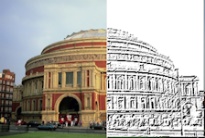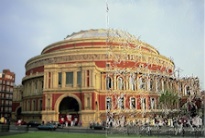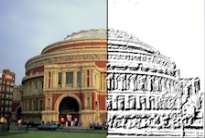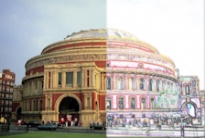You can apply Art Media effects to make an image look painted or drawn. You can simulate the use of traditional art media, including with pencil, charcoal, and chalk.
Edit workspace
The Black Pencil effect is similar to the Charcoal effect, but it uses thinner strokes and produces a more detailed image. You can access the Black Pencil dialog box by choosing Effects  Art Media Effects
Art Media Effects  Black Pencil.
Black Pencil.

The Black Pencil dialog box contains the following controls:
| • |
Detail — controls the number and darkness of the strokes |
| • |
Opacity — controls the strength of the effect. As the value increases, the image displays more of the effect and less of its original appearance. |
Edit workspace
The Brush Strokes effect makes your image look like an oil or watercolor painting. You can access the Brush Strokes dialog box by choosing Effects  Art Media Effects
Art Media Effects  Brush Strokes.
Brush Strokes.

The Brush Stroke dialog box contains the following controls:
| • |
Softness — determines the amount of blur in the image |
| • |
Bristles — specifies the number of bristles in the brush |
| • |
Width — controls the width of the brush |
| • |
Opacity — determines the strength of the effect |
| • |
Length — specifies the length of the brushstrokes |
| • |
Density — specifies the number of strokes in the image |
| • |
Angle — affects which edges appear light and shadowed. The needle points to the direction of the light source, measured in degrees of rotation around the circle. To set the value, you can click in the circle, drag the needle, or set or type a number in the control. |
| • |
Color — lets you choose a color for the light shining on the edges of the forms. You can click the color box to access the Color dialog box, or right-click the color box to access the Recent Colors dialog box. |
Edit workspace
The Charcoal effect is similar to the Black Pencil effect, but the thicker strokes produce an image containing less detail. You can access the Charcoal dialog box by choosing Effects  Art Media Effects
Art Media Effects  Charcoal.
Charcoal.

The Charcoal effect dialog box contains the following controls:
| • |
Detail — controls the number and darkness of the strokes |
| • |
Opacity — controls the strength of the effect. As the Opacity value increases, the image displays more of the effect and less of its original appearance. |
Edit workspace
The Colored Chalk effect uses the colors in the image to make the image appear drawn in colored chalk. Wider strokes appear with this effect than with the Colored Pencil effect.
You can access the Colored Chalk dialog box by choosing Effects  Art Media Effects
Art Media Effects  Colored Chalk.
Colored Chalk.

The Colored Chalk dialog box contains the following controls:
| • |
Detail — controls the number and darkness of the strokes |
| • |
Opacity — controls the strength of the effect. As the Opacity value increases, the image displays more of the effect and less of its original appearance. |
You can produce an effect similar to the Colored Chalk effect by using the Chalk tool found on the Tools toolbar.
Edit workspace
The Colored Pencil effect uses the colors in the image to make it appear drawn in colored pencil. The effect is similar to the Colored Chalk effect, but it uses thinner strokes. You can access the Colored Pencil dialog box by choosing Effects  Art Media Effects
Art Media Effects  Colored Pencil.
Colored Pencil.

The Colored Pencil dialog box contains the following controls:
| • |
Detail — controls the number and darkness of the strokes |
| • |
Opacity — controls the strength of the effect. As the Opacity value increases, the image displays more of the effect and less of its original appearance. |
Edit workspace
The Pencil effect enhances and colors the edges in the image to make the image look like a pencil drawing. You can access the Pencil dialog box by choosing Effects  Art Media Effects
Art Media Effects  Pencil.
Pencil.

The Pencil dialog box contains the following controls:
| • |
Luminance — adjusts the overall brightness of the image |
| • |
Blur — determines the softness of the image. As you increase the value, the image becomes less sharp. |
| • |
Color — lets you choose a color for the background, or non-edge area, of the image. To change the light color, you can click a color in the image, click the color box to access the Color dialog box, or right-click the color box to access the Recent Colors dialog box. |
| • |
Intensity — controls the contrast between the background and the edges. As you increase the contrast, more detail appears. |
Copyright 2013 Corel Corporation. All rights reserved.
![]() Art Media Effects
Art Media Effects ![]() Black Pencil.
Black Pencil.![]() Art Media Effects
Art Media Effects ![]() Brush Strokes.
Brush Strokes.![]() Art Media Effects
Art Media Effects ![]() Charcoal.
Charcoal.![]() Art Media Effects
Art Media Effects ![]() Colored Chalk.
Colored Chalk.![]() Art Media Effects
Art Media Effects ![]() Colored Pencil.
Colored Pencil.![]() Art Media Effects
Art Media Effects ![]() Pencil.
Pencil.